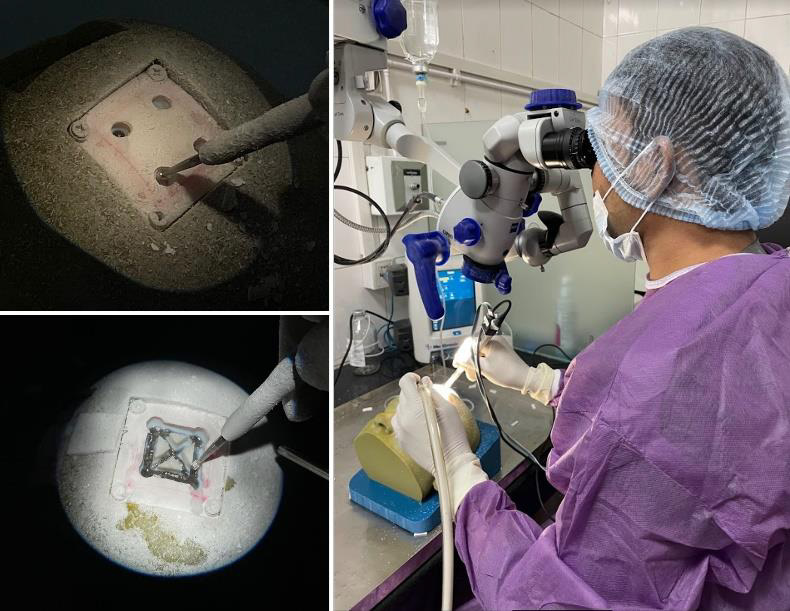More than a decade ago, Prof. Ashish Suri, chief investigator for the Neuro-engineering Lab at AIIMS Delhi, introduced 3D printing into his medical simulation program. Since that time, Stratasys 3D solutions have empowered the neurosurgical trainees at AIIMS Delhi to vastly improve their presurgical planning and research.
Prof. Suri sees 3D printing technology as an essential tool to achieve research and education goals for clinicians, which motivated him to build a dedicated lab to create highly realistic anatomical models. The lab is equipped with a Stratasys FDM printer™ , multi-color and multi-material Connex 3 printer, and the PolyJet J750 Digital Anatomy Printer™ to produce human bone and tissue models that demonstrate clinically validated realism in both feel and biomechanical performance.
Neurosurgery is one of the most technically demanding medical professions, warranting an exceptionally high level of expertise, skill, and finesse. The hands-on learning methods that have attempted to simulate real-life clinical situations have evolved significantly over time to meet these demands.
Animal or cadaver labs were among the earliest simulation tools for neurosurgical training, but ethical, cost, and religious concerns have accelerated the adoption of synthetic anatomical modeling for medical education. Though a less costly and controversial method for presurgical training, many early synthetic models have been unable to accurately mimic the feel and haptic response of human anatomy.
3D printing has emerged as an advanced tool for the development of high-fidelity neurosurgical simulators. The Stratasys J750 Digital Anatomy Printer™ with multi-material PolyJet 3D printing technology™ fabricates high-fidelity, multi-texture models for planning and training of operative procedures. These ultra-realistic anatomy models allow neurosurgeons to develop a clear visualization of the operative anatomy, significantly improving pre-operative planning through interaction with a patient-specific model.

Trainee performing simulation activity for burr
hole, straight and diagonal line drilling.
Prof. Suri and his team at AIIMS Delhi developed a novel craniotomy simulator using Stratasys 3D printing technology to teach and practice complex craniotomy procedures. The simulator is designed to replicate the microscopic high-speed drilling procedure that requires surgeons to create burr holes in the skull and remove the flap of the bone from the skull to expose the brain.
Predefined anatomical presets in the Stratasys GrabCAD Digital Anatomy Printer ™ Software have allowed researchers to mimic the anatomical structures and biomechanical properties of the skull using a unique combination of Stratasys BoneMatrix ™ , TissueMatrix, and Agilus30™ 3D print materials.
To allow trainees to practice drilling burr holes and lines like they would in a procedure, an outer body and base plate simulator were fabricated in polymer material using the Objet350 Connex3 printer. Drilling patches were created using the J750 Digital Anatomy Printer since fine detail and biomechanical accuracy were required.
Trainees who validated the simulator have found it to be a highly useful tool for honing their drilling skills.

Physical training models for ex vivo study on animal tissue like sheep’s head and scapula for drilling practice.
Neuro-endoscopic techniques demand a unique skillset, and even the smallest medical error can harm patients and drive healthcare costs. Recent developments in 3D printing have allowed medical simulation education to take on a new dimension—one where complex pathologies can be transformed into a physical 3D printed model. 3D printing has allowed trainees to acquire and improve surgical skills and knowledge in specifically fabricated and controlled settings with no risk to real patients. The simulation also offers the opportunity for deliberate practice and unlimited repetition so that psychomotor skills can become second nature.
Altem Technologies Pvt. Ltd, awarded one among “Top 100” companies in India by SME India Forum, is an engineering firm with core strengths in Product Life Cycle Management, and Additive Manufacturing (AM) Solutions and 3D Digitization Technologies. Altem offers a complete solution around and aspires to be a one stop for all 3D Printing, 3D Scanning, CAE, PLM and Life Sciences needs, with a wide spectrum of products for engineering & life sciences companies in India.

The Neuro-Engineering Workshop on 3D Printing in Medical Devices, Simulation, and Innovation was successfully conducted on December 14-15, 2024, at the India International Centre, New Delhi. The event served as a premier platform for knowledge exchange, featuring 20+ expert speakers, live demonstrations of cutting-edge 3D printing technologies, and a design competition showcasing groundbreaking healthcare innovations. With participation from 150+ attendees across India, the workshop facilitated insightful discussions on emerging trends, highlighting the transformative impact of 3D printing on medical device development, surgical simulation, and healthcare innovation. The event fostered multidisciplinary collaboration, creativity, and knowledge-sharing, reinforcing the role of 3D printing in shaping the future of healthcare technologies.